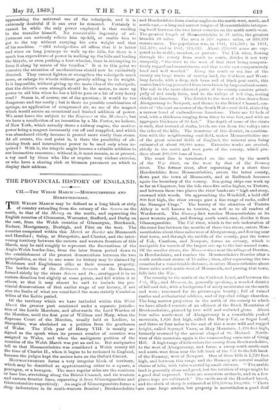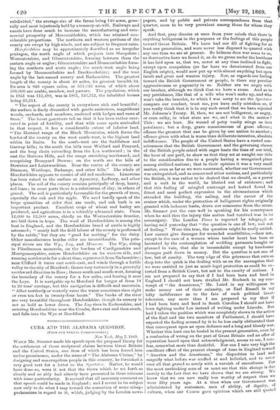THE PROVINCIAL HISTORY OF ENGLAND.
—4— ca.—THE WELSH MARCH :-MONMOUTHSHIRR AND HEREFORDSHIRE.
'THE WELSH MARCH may be defined as a long block or strip 'THE of country extending from the estuary of the Severn on the south, to that of the Mersey on the north, and separating the English counties of Gloucester, Worcester, Stafford, and Derby on the east, from the Welsh counties of Glamorgan, Brecknock, Radnor, Montgomery, Denbigh, and Flint on the west. The -counties comprised within this March or Border are Monmouth and Hereford ; Salop, or Shropshire, and Chester, and the intervening territory between the eastern and western frontiers of this March, may be said roughly to represent the fluctuations of the Anglo-Welsh border-line, from the later Saxon period down to the establishment of time present demarcations between the two principalities, so that in one sense its history may be claimed by Welshmen and Englishmen alike as their common property. The border-line of the Britannia Secunda of the Romans, 'formed chiefly by the rivers Severn and Dee, overlapped it in an eastern direction but slightly at some points, and fell within it at others, so that it may almost be said to include the provincial demarcations of that earlier stage of our history, if not also the limits of what are considered the more strictly Cambrian tribes of the Keltic period.
Of the territory which we have included within this Welsh March the greater part continued under a separate jurisdiction of the Lords Marchers, and afterwards the Lord Warden of the Marches, until the first year of William and Mary, when the Supreme Court of the Marches, usually held at Ludlow, in Shropshire, was abolished on a petition from the gentlemen of Wales. The 27th year of Henry VIII. is usually assigned as the epoch when its present number of counties was assigned to Wales, and when the ambiguous position of the counties of the Welsh March was put an end to. But antiquaries tell us that Monmouthshire was considered a Welsh county till the time of Charles IL, when it began to be reckoned in England, because the judges kept the assizes here on the Oxford Circuit. MONMOUTHSHIRE forms a very irregular block of territory, which may be described as approximating either to a square, a pentagon, or a hexagon. The most regular sides are the southern or base line, stretching along the Bristol Channel, and its western and eastern frontier lines, separating it from Glamorganshire and Gloucestershire respectively. Au angle of Glamorganshire forms a deep indentation in its south-western frontier ; Brecknockshire
and Herefordshire forum similar angles on the north-west, north, and north-east,—a long and narrow tongue of Montuouthshire interpos ing itself between the two latter counties on the north north-west.
The greatest length of Monmouthshire is 31 miles, the greatest breadth 28 miles. Time area is 576 square miles, or 368,399
statute acres. The population was, in 1811, 134,368 ; in 1831,
157,418; and in 1861, 174,633. About 270,000 acres aro supposed to be arablo, meadow, or pasture. The Usk river, tlowiug through the county from north to south, divides it not very unequally, " the tract to the west of that river being comparatively rugged and mountainous, and that to the east comparatively level and well wooded." Along the south or sea line of the county are large tracts of marshy land, the Caldecot and Wentlong Levels, with a deep, rich loam soil of black peat earth, this marsh land being protected from inundation by large embankments. The soil in the more elevated parts of the county consists principally of red sandy loam, and in the valleys of red clay, resting chiefly on limestone. The district to the west of a line drawn front Abergavenuy to Newport, and thence to the Bristol Channel, consists of "time coal-measures of the South Wales coalfield, skirted by a narrow baud of carboniferous limestone. There are 12 beds of coal, with a thickness ranging from three to nine feet, and with au aggregate thickness of 95 feet." The depth of some of the strata is such, that instead of shafts, levels are run from the valleys into the sides of the hills. The ironstone of this district, in combination with the neighbouring coal-field, makes Monmouthshire one of the great mineral fields of England, the mineral area being estimated at about s9,000 acres. Extensive works are erected, chiefly in the north and west parts of the county, which produce about 200,000 tons of iron.
The coast line is terminated on the east by the mouth of the Wye river, ou the west by that of the ltuntney river. The former river, after separating for a short time Herefordshire front Monmouthshire, enters the latter county, flows past the town of Monmouth, and at ltedbrook becomes again the boundary of the county. Sea-going ships can work up as far as Chepstow, but the tide rises five miles higher, to 'I'intern, and between these two places the river banks are " high and steep, crowned with woods. On approaching the IVindcliff, a bold cliff 800 feet high, the river sweeps past a fine range of rocks, called the Bamager Crags." The beauty of the situation of Tintern Abbey is well known to tourists, as well as to all readers of Wordsworth. '['he Rummy first touches Monmouthshire at its most western point, and flowing south south-east, divides it from Glamorganshire. The Usk river, which is the sole indentation of the coast line between the mouths of those two rivers, enters Monmouthshire about three miles west of Abergavenuy, and flowing near that town, and through time middle of the county, past the towns of Usk, Caerleon, and Newport, forms an estuary, which is navigable for vessels of time largest size up to the last-named town. Of the smaller rivers, the Mannew rises near the village of Derston, in Herefordshire, and reaches the Monntoutimshire frontier after a south south-cast course of 15 miles ; then, after separating the two counties for a considerable distance, it enters Monmouthshire about three miles north north-west of :Monmouth, and passing that town, falls into the Wye.
The country to the north of time Caldecot Level, and between the Usk, Wye, and Ilhootow, is, generally speaking, a wooded district of hill and dale, with a background of misty mountains on the north and west ; renowned for its picturesque beauty ; full of ruined castles and ecclesiastical edifices, and of ivy-clad village churches. The long narrow projection in the north of the county to which we have alluded consists of an offshoot of the Black Mountains of Brecknockshire, pierced by two wild and secluded glens. About four miles north-west of Abergavenuy is a remarkable peaked mountain, 1,856 feet high, called the Pen-y-Val, or Sugar Loaf, and three or four miles to the east of this a more wild and rugged height, called Scyrryd Vawr, or Holy Mountain, 1,498 feet high, formerly crowned by the ancient chapel of St. Michael. Northwest of this mountain again is the commanding eminence of Graig Hill. A high range of hills enters the county from Brecknockshire, to the west of Abergavenny, and forms a sweep south south-east and south-west from near the left bank of the Usk to the left bank of the Rumney, west of Newport. One of these hills is 1,720 feet high, and between this range and the Rumney arc several smaller chains of hills, with vales watered by small streams. " The arable land is generally clean and good, but the rotation of crops might be a good deal improved. There are numerous orchards, and in a few places hops are cultivated." The cattle are of the Hereford breed, and the stock of sheep is estimated at 170,000 to 180,000. "Thera are some large estates, but property is nevertheless a good deal
subdivided," the average size of the farms being 140 acres, generally and most injuriously held by a tenancy-at-will. Railways and canals have done much to increase the manufacturing and commercial prosperity of Monmouthshire, which has attained considerable proportions. The northern and western portions of the county are swept by high winds, and are subject to frequent rains.
Herefordshire may be approximately described as an irregular pentagon, the north angle of which projects into Shropshire ; Worcestershire, and Gloucestershire, forming between them the eastern angle or angles; Gloucestershire and Monmouthshire forming the southern and acute angle ; the south-west angle being formed by Monmouthshire and Brecknockshire ; and the west angle by the last-named county and Radnorshire. The greatest length of the county is about 40 miles, its greatest breadth 34. Its area is 836 square miles, or 534,823 acres, of which about 500,000 are arable, meadow, and pasture. The population, which in 1851 was 115,489, was in 1861, 123,712, the inhabited houses being 25,314.
" The aspect of the county is everywhere rich and beautiful ; the surface is finely diversified with gentle eminences, magnificent woods, orchards, and meadows, enclosed with hedges and rows of trees." The latest gazetteers tell us that it has been rather overrated in point of fertility, and that with sonic spots unrivalled in that respect, it has a considerable extent of inferior land. "The Hatterel range of the Black Mountains, which forms the harder of the county on the west south-west, is the highest land within its limits. In the south-west are the Saddlebow and Garway hills; in the south the hills near Walford and Penyard, and the long chain extending from the L.2s northward ; in the east the Malvern Hills, and the range stretching northward, and comprising Bromyard Downs ; on the north are the hills of Downten and Leintwardrine. Near the centre of the county are Dinmore, Westhope, Badmage, and other hills." The whole of Herefordshire appears to consist of old red sandstone. Limestone has been raised to the surface at Aymestry, Ledbury, and other places. The soil of the county consists principally of deep, heavy, red loam; in some parts there is a substratum of clay, in others of gravel. The soil is particularly favourable for the growth of trees, especially the oak and the apple. We need hardly speak of the large quantities of cider that are made, and oak bark is an important product. Excellent crops of wheat and barley are produced, and agriculture is in a tolerably advanced state. From 12,000 to 12,500 acres, chiefly on the Worcestershire frontier, are laid down in hops. The wool of Herefordshire is among the best in England, and the Herefordshire breed of cattle is highly esteemed ; " nearly half the field labour of the county is performed by the cattle," but they are " good for nothing" for the dairy. Other manufactures besides cider are inconsiderable. The principal rivers are the II-ye, Lug, and Munnoro. The 117ge, rising in Plimlimmon mountain, on the borders of Cardiganshire and Montgomeryshire, enters Herefordshire on its western side, and running northwards for a short time, separates it from Radnorshire ; near Clifford it tarns east south-east, and winds through a fertile valley to the city of Hereford ; thence very tortuously in a generally southward direction to Ross ; thence south and south-west, forming the boundary of the county for a few miles, and leaving it near the Leys. It is navigable up to Hereford for barges of from 18 to 20 tons' carriage, but this navigation is difficult and uncertain. " After northerly or westerly rains the water sometimes rises eight or even ten feet in twenty-four hours." The banks of the river are very beautiful throughout Herefordshire, though its scenery is not so bold as lower down. The Lug rises in Radnorshire, and entering Herefordshire near the Combe, flows east and then south, and falls into the Wye at Mordiford.































 Previous page
Previous page